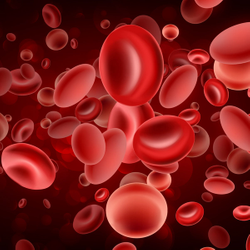Step-Up Teclistamab Dosing Produces Responses in R/R Multiple Myeloma
Giving tocilizumab before step-up dosing of teclistamab may mitigate cytokine release syndrome in relapsed/refractory multiple myeloma.
Previously reported results from the phase 2 MajesTEC-1 study (NCT04557098) evaluating 165 patients showed an overall response rate (ORR) of 63.0%, a stringent CR rate of 37.6%, a VGPR rate of 13.9%, and a PR of 3.6%.

A step-up dose of teclistamab-cqyv (Tecvayli) plus prophylactic tocilizumab (Actemra) elicited evaluable responses in a small cohort of patients with relapsed/refractory multiple myeloma, according to results from the phase 2 OPTec trial (NCT05972135) presented as a poster during the 2024 American Society of Clinical Oncology (ASCO) Annual Meeting.1
Of the 11 patients enrolled, 5 had responses after 2 cycles of therapy, with 3 patients having a partial response (PR) and 2 having a very good partial response (VGPR). After 4 lines of therapy, 1 patient had a PR, and 4 had VGPRs.
The investigators hypothesized that a step-up dose in the outpatient setting could make teclistamab more accessible for those who have limited treatment options. Currently, teclistamab is the only FDA-approved B-cell maturation antigen and CD3 bispecific antibody that has a personalized weight-based dosing schedule.2
Previously reported results from the phase 2 MajesTEC-1 study (NCT04557098) evaluating 165 patients showed an overall response rate (ORR) of 63.0%, a stringent CR rate of 37.6%, a VGPR rate of 13.9%, and a PR of 3.6%.3
Additionally, cytokine release syndrome (CRS) was notable but mainly grade 1/2.4 Tocilizumab was used to manage CRS. In MajesTEC-1, those who were given tocilizumab during their first CRS event had a 20% recurrence rate vs 62% who did not receive treatment.
The OPTec study was set to evaluate 50 patients receiving teclistamab in patients with relapsed/refractory multiple myeloma. The initial cohort, which is presented in the findings, was intended to evaluate the pharmacokinetics and pharmacodynamic profiles as well as the effect of tocilizumab on IL-6, IL-6R, and C-reactive proteins.
In the outpatient setting, tocilizumab was given as a single 8 mg/kg intravenous dose 2 to 4 hours before step-up dose 1 with teclistamab. Additional treatment included 2 step-up doses of teclistamab that will be given at 1.5 mg/kg via weekly administration for 12 28-day cycles.
The primary end point was the incidence of CRS in the first 2 cycles of tocilizumab prior to the step-up teclistamab dose. Secondary end points included grade 2 or higher CRS, recurrent CRS, all-grade CRS, neurotoxicity, grade 3 or higher infections, neutropenia and febrile neutropenia, and ORR.
The median patient age was 70 years old, with 6 female patients and 5 male patients having been enrolled. Additionally, the median number of lines of prior therapy was 8.
Regarding safety, the first 11 patients did not meet the stopping criteria for grade 3 or higher CRS or neurotoxicity. The most common adverse effects (AEs) included headache (n = 5), nausea (n = 5), neutropenia (n = 4), and injection site reactions (n = 4). During treatment with tocilizumab or teclistamab, no patient required hospitalization. Grade 2 infection of the upper respiratory tract and urinary tract was noted in 1 patient, and 2 patients had either grade 2 candida infection or grade 2 viral upper respiratory tract infection.
Overall, 10 patients completed the step-up dosing regimen. One patient was withdrawn from the study due to a serious AE of bilateral leg weakness and pain that was unrelated to either regimen. The patient died 2 weeks later from unknown causes.
Moving forward, additional analyses are planned for 40 additional patients at 12 different sites to see if tocilizumab prior to teclistamab may mitigate CRS risk and improve outpatient accessibility. Of note, talquetamab is being added as a protocol amendment to broaden the potential of using tocilizumab with other approved bispecific antibodies.
References
- Rifkin RM, Schade HH, Simmons GL, et al. OPTec: a phase 2 study to evaluate outpatient (OP) step-up dosing administration of teclistamab (Tec), a BCMA-targeting bispecific antibody, in patients (Pts) with relapsed/refractory multiple myeloma (RRMM). J Clin Oncol. 2024;42(suppl 16):7528. doi: 10.1200/JCO.2024.42.16_suppl.7528
- FDA approves teclistamab-cqyv for relapsed or refractory multiple myeloma. News release. FDA. October 25, 2022. Accessed June 3, 2024. https://shorturl.at/rYndz
- Martin TG, Mateos MV, Nooka A, et al. Detailed overview of incidence and management of cytokine release syndrome observed with teclistamab in the MajesTEC-1 study of patients with relapsed/refractory multiple myeloma. Cancer. 2023;129(13):2035-2046. doi:10.1002/cncr.34756
- Van de Donk NWCJ, Moreau P, Garfall P, et al. Long-term follow-up from MajesTEC-1 of teclistamab, a B-cell maturation antigen (BCMA) x CD3 bispecific antibody, in patients with relapsed/refractory multiple myeloma (RRMM). J Clin Oncol. 2023;41(suppl 16). doi:10.1200/JCO.2023.41.16_suppl.8011